Abstract
VEPs were recorded with three different spatial frequencies of stimulation in patients affected by idiopathic Parkinsonism and by Parkinsonian syndromes. The detection of VEP abnormalities in Parkinson's disease was dependent on the spatial frequency of the visual stimulus (a vertical square wave grating). The VEP latency was normal in Parkinsonian syndrome patients (except in one patient affected by familial Parkinsonism). Dopamine precursor therapy differently reduced the VEP latency, depending on the spatial frequency of the visual stimulus. These findings suggest that the dopaminergic mechanism involved in the generation of VEP delays is sensitive to stimulus spatial frequency. The study of VEPs before and after the administration of haloperidol confirmed this hypothesis. VEP latency did not correlate with the major clinical symptoms of Parkinson's disease and could not predict the results of chronic dopaminergic therapy.
Full text
PDF
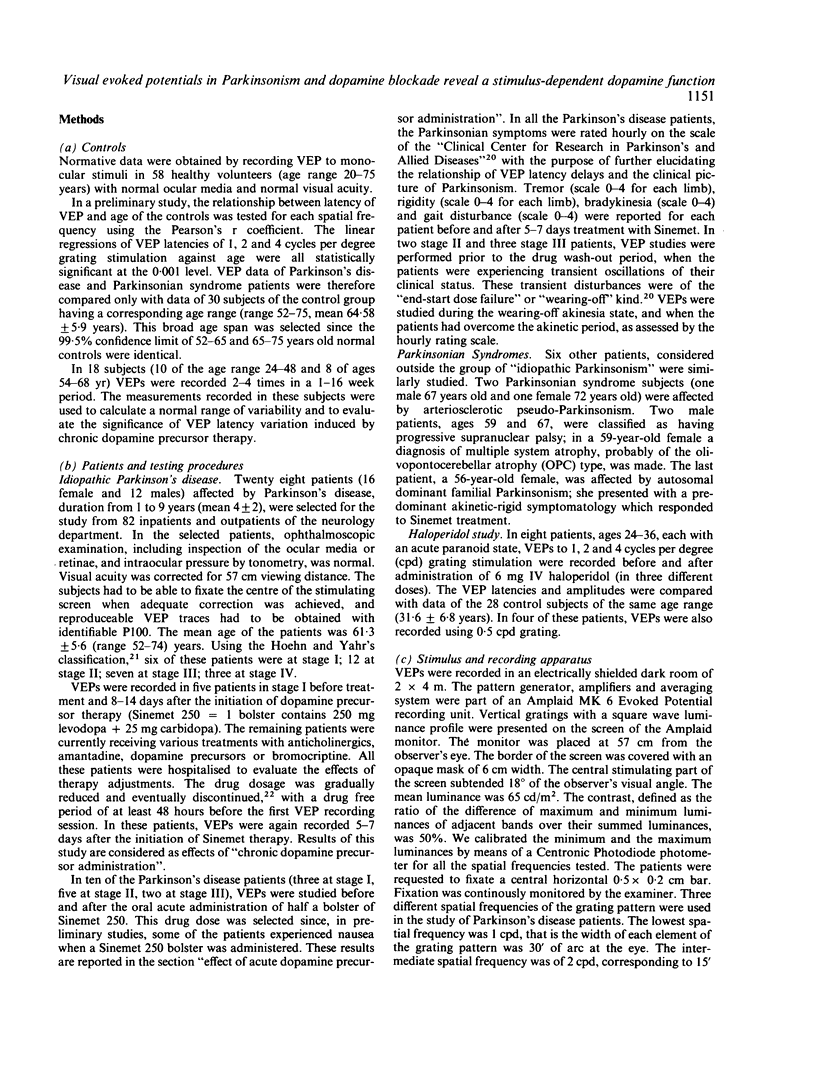

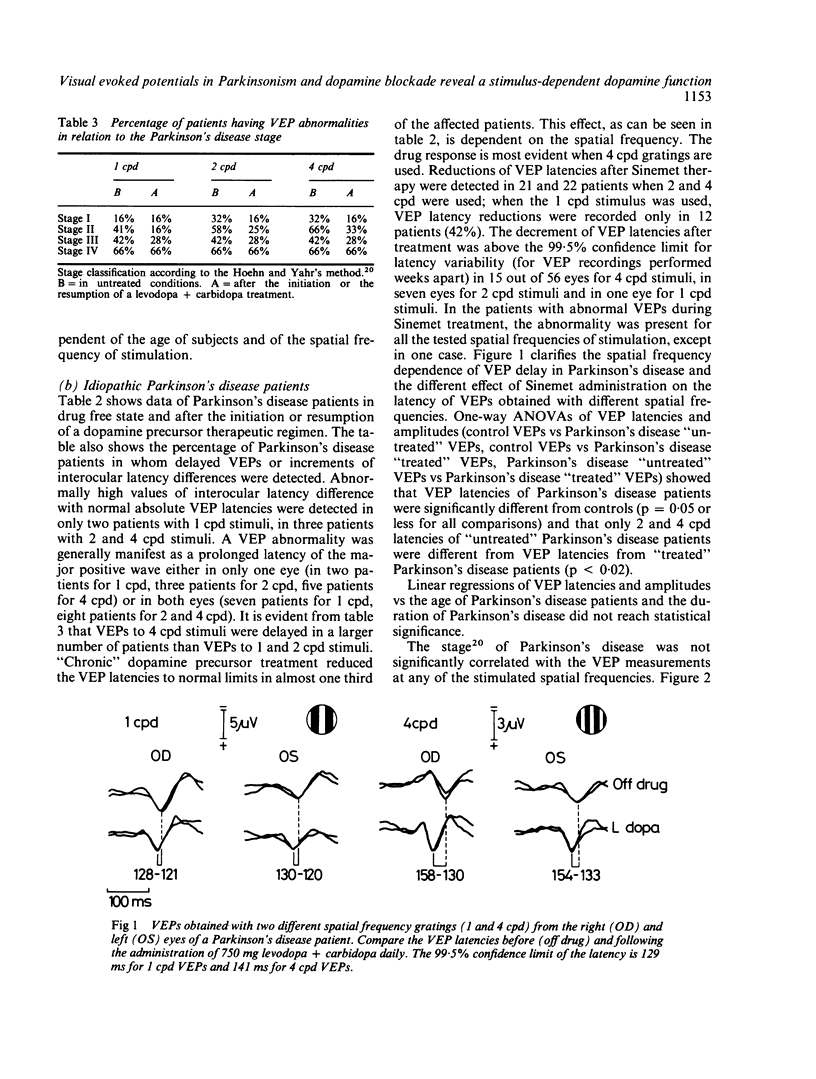

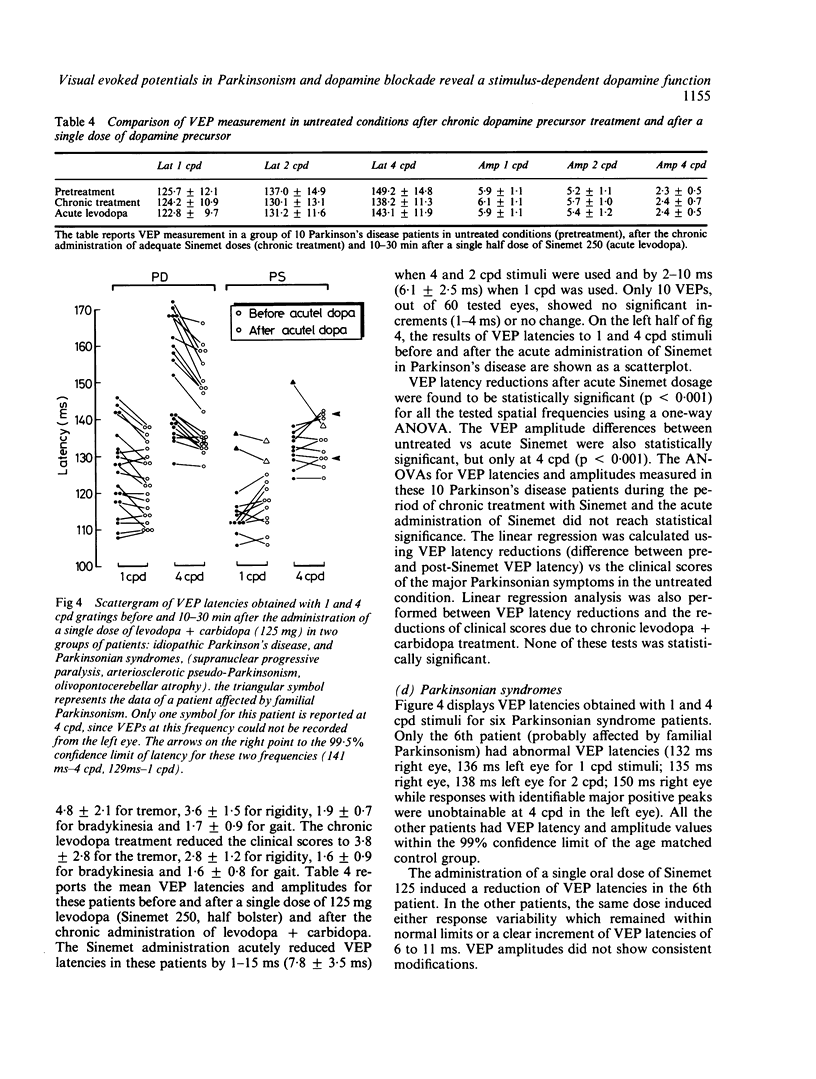

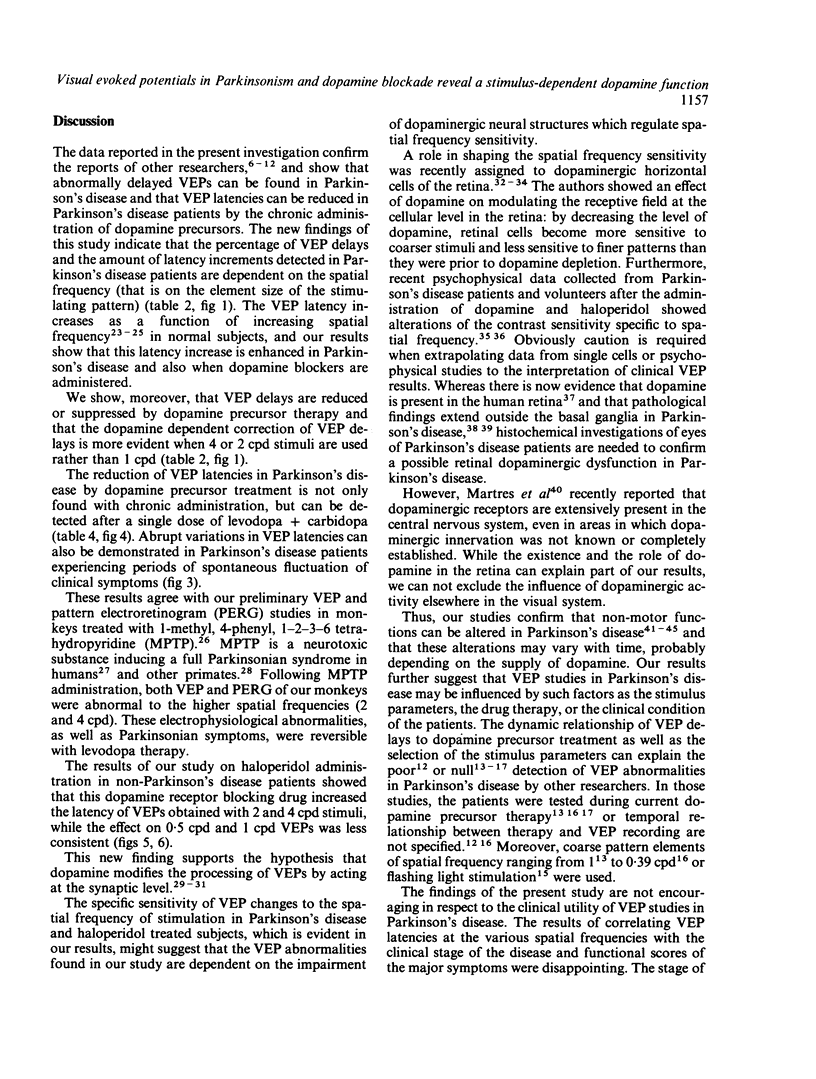

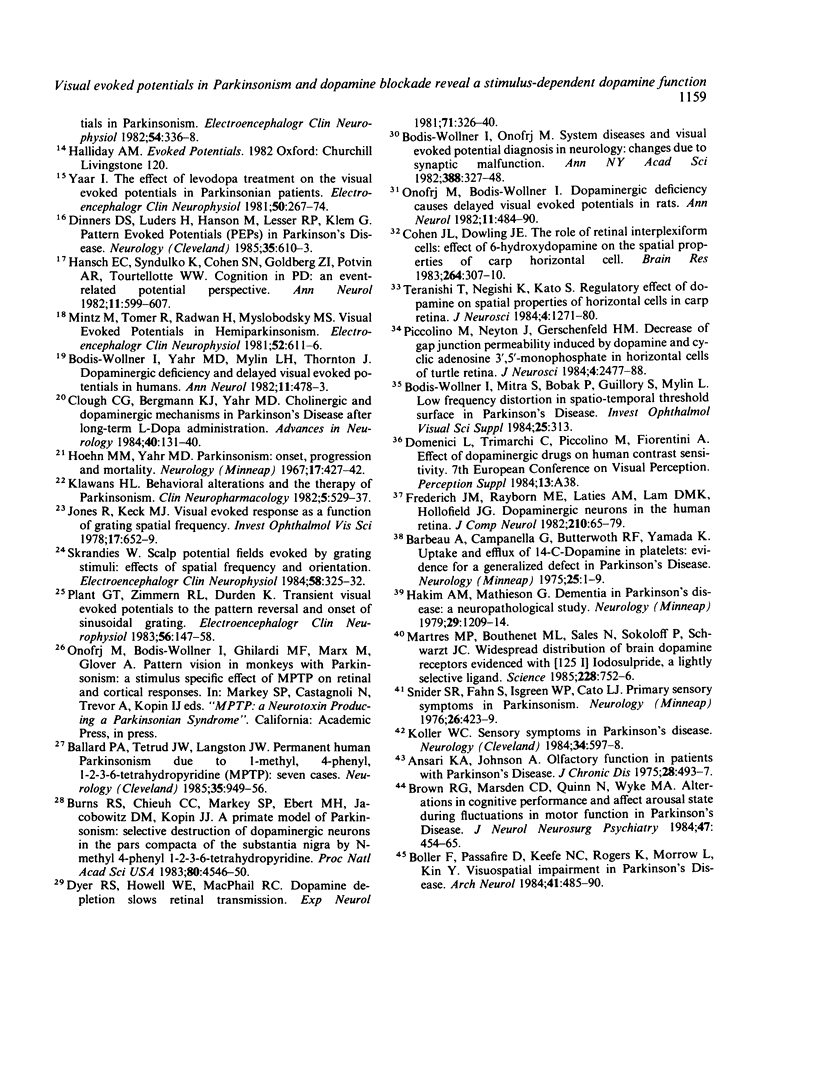
Selected References
These references are in PubMed. This may not be the complete list of references from this article.
- Ansari K. A., Johnson A. Olfactory function in patients with Parkinson's disease. J Chronic Dis. 1975 Oct;28(9):493–497. doi: 10.1016/0021-9681(75)90058-2. [DOI] [PubMed] [Google Scholar]
- Ballard P. A., Tetrud J. W., Langston J. W. Permanent human parkinsonism due to 1-methyl-4-phenyl-1,2,3,6-tetrahydropyridine (MPTP): seven cases. Neurology. 1985 Jul;35(7):949–956. doi: 10.1212/wnl.35.7.949. [DOI] [PubMed] [Google Scholar]
- Barbeau A., Campanella G., Butterworth R. F., Yamada K. Uptake and efflux of 14-C-dopamine in platelets: evidence for a generalized defect in Parkinson's disease. Neurology. 1975 Jan;25(1):1–9. doi: 10.1212/wnl.25.1.1. [DOI] [PubMed] [Google Scholar]
- Bird T. D., Crill W. E. Pattern-reversal visual evoked potentials in the hereditary ataxias and spinal degenerations. Ann Neurol. 1981 Mar;9(3):243–250. doi: 10.1002/ana.410090307. [DOI] [PubMed] [Google Scholar]
- Bodis-Wollner I., Onofrj M. System diseases and visual evoked potential diagnosis in neurology: changes due to synaptic malfunction. Ann N Y Acad Sci. 1982;388:327–348. doi: 10.1111/j.1749-6632.1982.tb50800.x. [DOI] [PubMed] [Google Scholar]
- Bodis-Wollner I., Yahr M. D. Measurements of visual evoked potentials in Parkinson's disease. Brain. 1978 Dec;101(4):661–671. doi: 10.1093/brain/101.4.661. [DOI] [PubMed] [Google Scholar]
- Bodis-Wollner I., Yahr M. D., Mylin L., Thornton J. Dopaminergic deficiency and delayed visual evoked potentials in humans. Ann Neurol. 1982 May;11(5):478–483. doi: 10.1002/ana.410110507. [DOI] [PubMed] [Google Scholar]
- Boller F., Passafiume D., Keefe N. C., Rogers K., Morrow L., Kim Y. Visuospatial impairment in Parkinson's disease. Role of perceptual and motor factors. Arch Neurol. 1984 May;41(5):485–490. doi: 10.1001/archneur.1984.04050170031011. [DOI] [PubMed] [Google Scholar]
- Brown R. G., Marsden C. D., Quinn N., Wyke M. A. Alterations in cognitive performance and affect-arousal state during fluctuations in motor function in Parkinson's disease. J Neurol Neurosurg Psychiatry. 1984 May;47(5):454–465. doi: 10.1136/jnnp.47.5.454. [DOI] [PMC free article] [PubMed] [Google Scholar]
- Burns R. S., Chiueh C. C., Markey S. P., Ebert M. H., Jacobowitz D. M., Kopin I. J. A primate model of parkinsonism: selective destruction of dopaminergic neurons in the pars compacta of the substantia nigra by N-methyl-4-phenyl-1,2,3,6-tetrahydropyridine. Proc Natl Acad Sci U S A. 1983 Jul;80(14):4546–4550. doi: 10.1073/pnas.80.14.4546. [DOI] [PMC free article] [PubMed] [Google Scholar]
- Carroll W. M., Kriss A., Baraitser M., Barrett G., Halliday A. M. The incidence and nature of visual pathway involvement in Friedreich's ataxia. A clinical and visual evoked potential study of 22 patients. Brain. 1980 Jun;103(2):413–434. doi: 10.1093/brain/103.2.413. [DOI] [PubMed] [Google Scholar]
- Clough C. G., Bergmann K. J., Yahr M. D. Cholinergic and dopaminergic mechanisms in Parkinson's disease after long-term L-DOPA administration. Adv Neurol. 1984;40:131–140. [PubMed] [Google Scholar]
- Cohen J. L., Dowling J. E. The role of the retinal interplexiform cell: effects of 6-hydroxydopamine on the spatial properties of carp horizontal cells. Brain Res. 1983 Apr 4;264(2):307–310. doi: 10.1016/0006-8993(83)90830-2. [DOI] [PubMed] [Google Scholar]
- Delwaide P. J., Mesraoua B., De Pasqua V. Les potentiels évoqués visuels dans la maladie de Parkinson. Rev Electroencephalogr Neurophysiol Clin. 1980 Oct-Dec;10(4):338–342. doi: 10.1016/s0370-4475(80)80031-1. [DOI] [PubMed] [Google Scholar]
- Dinner D. S., Lüders H., Hanson M., Lesser R. P., Klem G. Pattern evoked potentials (PEPs) in Parkinson's disease. Neurology. 1985 Apr;35(4):610–613. doi: 10.1212/wnl.35.4.610. [DOI] [PubMed] [Google Scholar]
- Ehle A. L., Stewart R. M., Lellelid N. E., Leventhal N. A. Normal checkerboard pattern reversal evoked potentials in parkinsonism. Electroencephalogr Clin Neurophysiol. 1982 Sep;54(3):336–338. doi: 10.1016/0013-4694(82)90182-1. [DOI] [PubMed] [Google Scholar]
- Frederick J. M., Rayborn M. E., Laties A. M., Lam D. M., Hollyfield J. G. Dopaminergic neurons in the human retina. J Comp Neurol. 1982 Sep 1;210(1):65–79. doi: 10.1002/cne.902100108. [DOI] [PubMed] [Google Scholar]
- Gawel M. J., Das P., Vincent S., Rose F. C. Visual and auditory evoked responses in patients with Parkinson's disease. J Neurol Neurosurg Psychiatry. 1981 Mar;44(3):227–232. doi: 10.1136/jnnp.44.3.227. [DOI] [PMC free article] [PubMed] [Google Scholar]
- Hakim A. M., Mathieson G. Dementia in Parkinson disease: a neuropathologic study. Neurology. 1979 Sep;29(9 Pt 1):1209–1214. doi: 10.1212/wnl.29.9_part_1.1209. [DOI] [PubMed] [Google Scholar]
- Halliday A. M., Halliday E., Kriss A., McDonald W. I., Mushin J. The pattern-evoked potential in compression of the anterior visual pathways. Brain. 1976 Jun;99(2):357–374. doi: 10.1093/brain/99.2.357. [DOI] [PubMed] [Google Scholar]
- Halliday A. M., McDonald W. I., Mushin J. Delayed visual evoked response in optic neuritis. Lancet. 1972 May 6;1(7758):982–985. doi: 10.1016/s0140-6736(72)91155-5. [DOI] [PubMed] [Google Scholar]
- Hansch E. C., Syndulko K., Cohen S. N., Goldberg Z. I., Potvin A. R., Tourtellotte W. W. Cognition in Parkinson disease: an event-related potential perspective. Ann Neurol. 1982 Jun;11(6):599–607. doi: 10.1002/ana.410110608. [DOI] [PubMed] [Google Scholar]
- Hoehn M. M., Yahr M. D. Parkinsonism: onset, progression and mortality. Neurology. 1967 May;17(5):427–442. doi: 10.1212/wnl.17.5.427. [DOI] [PubMed] [Google Scholar]
- Jones R., Keck M. J. Visual evoked response as a function of grating spatial frequency. Invest Ophthalmol Vis Sci. 1978 Jul;17(7):652–659. [PubMed] [Google Scholar]
- Kupersmith M. J., Shakin E., Siegel I. M., Lieberman A. Visual system abnormalities in patients with Parkinson's disease. Arch Neurol. 1982 May;39(5):284–286. doi: 10.1001/archneur.1982.00510170026007. [DOI] [PubMed] [Google Scholar]
- Livingstone I. R., Mastaglia F. L., Edis R., Howe J. W. Visual involvement in Friedreich's ataxia and hereditary spastic ataxia. A clinical and visual evoked response study. Arch Neurol. 1981 Feb;38(2):75–79. doi: 10.1001/archneur.1981.00510020033003. [DOI] [PubMed] [Google Scholar]
- Martres M. P., Bouthenet M. L., Sales N., Sokoloff P., Schwartz J. C. Widespread distribution of brain dopamine receptors evidenced with [125I]iodosulpride, a highly selective ligand. Science. 1985 May 10;228(4700):752–755. doi: 10.1126/science.3838821. [DOI] [PubMed] [Google Scholar]
- Mintz M., Tomer R., Radwan H., Myslobodsky M. S. Visual evoked potentials in hemiparkinsonism. Electroencephalogr Clin Neurophysiol. 1981 Dec;52(6):611–616. doi: 10.1016/0013-4694(81)91435-8. [DOI] [PubMed] [Google Scholar]
- Onofrj M., Bodis-Wollner I. Dopaminergic deficiency causes delayed visual evoked potentials in rats. Ann Neurol. 1982 May;11(5):484–490. doi: 10.1002/ana.410110508. [DOI] [PubMed] [Google Scholar]
- Piccolino M., Neyton J., Gerschenfeld H. M. Decrease of gap junction permeability induced by dopamine and cyclic adenosine 3':5'-monophosphate in horizontal cells of turtle retina. J Neurosci. 1984 Oct;4(10):2477–2488. doi: 10.1523/JNEUROSCI.04-10-02477.1984. [DOI] [PMC free article] [PubMed] [Google Scholar]
- Plant G. T., Zimmern R. L., Durden K. Transient visually evoked potentials to the pattern reversal and onset of sinusoidal gratings. Electroencephalogr Clin Neurophysiol. 1983 Aug;56(2):147–158. doi: 10.1016/0013-4694(83)90069-x. [DOI] [PubMed] [Google Scholar]
- Regan D., Neima D. Visual fatigue and visual evoked potentials in multiple sclerosis, glaucoma, ocular hypertension and Parkinson's disease. J Neurol Neurosurg Psychiatry. 1984 Jul;47(7):673–678. doi: 10.1136/jnnp.47.7.673. [DOI] [PMC free article] [PubMed] [Google Scholar]
- Skrandies W. Scalp potential fields evoked by grating stimuli: effects of spatial frequency and orientation. Electroencephalogr Clin Neurophysiol. 1984 Oct;58(4):325–332. doi: 10.1016/0013-4694(84)90058-0. [DOI] [PubMed] [Google Scholar]
- Snider S. R., Fahn S., Isgreen W. P., Cote L. J. Primary sensory symptoms in parkinsonism. Neurology. 1976 May;26(5):423–429. doi: 10.1212/wnl.26.5.423. [DOI] [PubMed] [Google Scholar]
- Tartaglione A., Pizio N., Bino G., Spadavecchia L., Favale E. VEP changes in Parkinson's disease are stimulus dependent. J Neurol Neurosurg Psychiatry. 1984 Mar;47(3):305–307. doi: 10.1136/jnnp.47.3.305. [DOI] [PMC free article] [PubMed] [Google Scholar]
- Teranishi T., Negishi K., Kato S. Regulatory effect of dopamine on spatial properties of horizontal cells in carp retina. J Neurosci. 1984 May;4(5):1271–1280. doi: 10.1523/JNEUROSCI.04-05-01271.1984. [DOI] [PMC free article] [PubMed] [Google Scholar]
- Yaar I. The effect of levodopa treatment on the visual evoked potentials in Parkinsonian patients. Electroencephalogr Clin Neurophysiol. 1980 Nov;50(3-4):267–274. doi: 10.1016/0013-4694(80)90154-6. [DOI] [PubMed] [Google Scholar]


